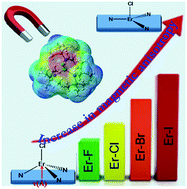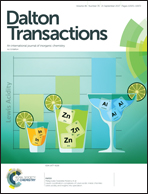Key role of higher order symmetry and electrostatic ligand field design in the magnetic relaxation of low-coordinate Er(iii) complexes†
Abstract
The conceptual framework of electrostatic ligand field modulation based on oblate/prolate type electron density of lanthanide ions is one of the most successful approaches to enhance barrier height in lanthanide-based single-ion magnets. Recently, a tetra coordinated [Er{N(SiMe3)2}s3Cl]·2THF (1) complex with an unfavourable ligand field showed slow relaxation of magnetization in zero field and challenges the concept of electrostatic ligand field modulation. To unravel the magnetic relaxation in this complex, we carried out a detailed theoretical investigation on three Er(III) complexes belonging to the same family of single-ion magnets. The CASSCF/PT2 + RASSI-SO approach highlights that the concept of electrostatic ligand field modulation based on oblate/prolate type is still valid in these complexes, and the relaxation dynamics observed can be rationalized by accounting for both the symmetry and geometrical distortions around the Er(III) ion. Using ab initio computed blockade barriers and crystal field analysis, we analysed the key components of the magnetic relaxation. Our study suggests that in these structures, the Er(III) ion shifted out of the triangular plane formed by the three nitrogen donor atoms and this out-of-plane shift (τ) significantly influences the slow-relaxation of magnetization. In order to gain deeper insights into the nature of metal–ligand bonding, and to predict quantitatively the strength of the axial and equatorial ligand field, ELF, QTAIM, and EDA analysis were carried out in these complexes. Our findings highlight that the molecules possessing large barrier height for magnetic relaxation are due to the combined effect of a favourable ligand field and the symmetry around the Er(III) ion. To understand the intricate role of both effects, several robust magneto-structural correlations were developed. Besides, the lanthanide-halogen covalency was also found to play a vital role in controlling the magnetic anisotropy and thus the magnetic relaxation. A near linear trend was observed between the calculated barrier height and the increase in the Er–X covalency as we move from –F to –I. This offers a de novo approach to increase barrier height in mononuclear lanthanide based complexes.



 Please wait while we load your content...
Please wait while we load your content...